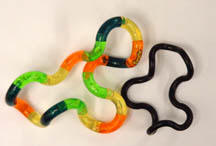BACKGROUND:
Children love to play
with different shaped blocks and build structures. The inherent beauty
of these three-dimensional objects is somehow lost when mathematics turns
to paper and pencil arithmetic. Keep in mind that because a child
is not good in arithmetic computation, doesn't mean the child cannot conceptualize
higher mathematical skills.
The least needed skill in science
is computational skill because addition, subtraction, multiplication, and
division are easily obtainable by a calculator. This doesn't mean
these parts of mathematics are not important, they just are not the door
that opens children's minds to higher mathematics. This activity
exposes students to a different field of mathematics that is more abstract
and has more direct relationship to science.
Mathematics also relates to
nature. Emphasize that the importance of mathematical relationships
helps determine patterns in nature. We give students the skills to
measure straight objects, but most objects are curved. Even a straight
line must curve sometimes. (If we were a flat Earth a line could be straight,
but a continuous line will eventually curve!) Mathematics is almost
mystical because the results are sometimes not easily explained.
PROCEDURE:
- This activity
has more questions than answers and is like a mathematical puzzle.
If geometrically based puzzles are available, include them with this lab.

- This lab also tries
to show mathematics as a subject that can be fun as well as complicated.
Topology is a branch of mathematics that relates the points of an object
that can be distorted. A lump of clay is a collection of points that
can be squeezed without changing topologically. Shape and size are
unimportant, but the connectivity of a figure is. This is very different
from the strict measurements we usually require of students.
Remember that the Earth, Solar System, and Universe are all somehow connected
but the points keep changing in space. Topology simply is the study
of closed curves. Just think of it, a sphere and a potato are topologically
equivalent!
- Use a product called "tangles." When closed, a tangle is a good example of
how a closed surface can make many shapes. These shapes are topologically
related. Follow the worksheet and have students work out the problems.
Remember the key objective is for students to relate to curves and discover
how difficult it is to describe and quantitate curves.
- ANSWERS:
- Students should make
3 shapes that are topologically related. Notice that although the
circumference of the closed curve remains the same, the area inside changes
constantly. Have students use the 16 segments of the small tangle.
Trace
the curves on the worksheet. Use the larger tangle to show unique
shapes to the entire class.
- Students are asked
to see if they can make a knot from the closed curve of 16 segments.
They cannot. They are then asked to make a knot by unsnapping just
one link. If students have difficulty with this, have them think
of the tangle as a shoe lace and then ask them to make a knot. Have
the students compare a knot with a closed curve. They will notice
that the knot interweaves where the closed curve does not.
- Keeping the tangles
closed, have students make a coil. This will require them to "wrap"
the curves.
- Students are asked
if the curved surface can be made flat if they unsnap one of the links
on the tangle. Yes, they can, if they make the tangle in a undulating
wave pattern. Students are then asked if they can measure the curves
with a ruler. The answer is no, curves are difficult to measure and
have to be determined by a mathematical relationship that includes using
the constant pi (determining the circumference of a circle).
- Students are asked
to make as many circles from the tangles of 16 curves. They will
find that they can make 4 (4 curves make one circle). Give them instructions
of how to find the circumference of the outside circle and the inside
circle. Measure the diameter and multiply by pi or 3.14. The
circles are 2.5 cm on the outside and 1.5 on the inside. The circumference
is 2.5 times 3.14 (7.85) and 1.5 times 3.14 (4.71). An easy way to
refer to the circumference is 2.5 pi and 1.5 pi. Now, can the students
determine the length of the tangle. Yes. Some of the students
may figure there are 4 complete circles. That means the outside total
circumference is 4 times 2.5 pi and inside circumference is 4 times 1.5
pi. The answer for the total length of the outside is 10 pi or 31.4
cm and the inside is 6 pi or 18.84 cm.
- You may want to use the larger tangle with 18
segments and repeat the exercises above.
- Remember, this activity
is to help students realize that mathematics is a tool to model the real
world. The higher the math they take (and the better the teacher)
the more exciting math becomes. It is part of our life, whether we
like it or not!
|